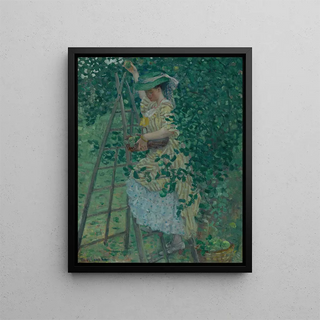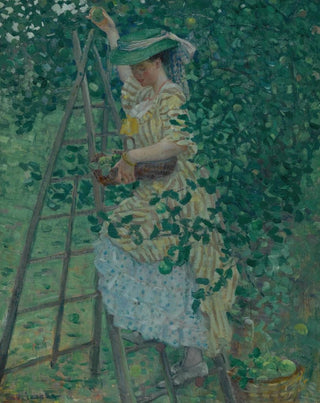Art print | Le Pommier - Frederick Carl Frieseke


View from behind

Frame (optional)
Reproduction Le Pommier - Frederick Carl Frieseke – Captivating Introduction
In the enchanting landscape of Impressionist art, "Le Pommier" by Frederick Carl Frieseke stands out for its delicacy and luminosity. This artwork, which captures the very essence of a fleeting moment, transports us to a lush garden where nature and humanity intertwine gracefully. Gazing at this painting, one is immediately enveloped by an atmosphere of serenity, almost tangible, where each brushstroke seems to whisper the secrets of a beautiful summer day. The artist manages to evoke a sense of calm and fullness, inviting the viewer to escape into a world where time appears suspended.
Style and uniqueness of the work
Frieseke's style is characterized by a vibrant color palette and an unparalleled mastery of light. In "Le Pommier," there is a bold use of pastel tones, harmoniously blending to create a soft, dreamlike ambiance. The play of shadow and light, typical of Impressionism, is here enhanced by an outdoor painting technique, allowing the artist to capture the vibrancy of natural colors. The composition of the artwork, centered on a flowering apple tree, is both simple and refined, revealing the beauty of details that often escape our gaze. The human figures, although present, are integrated in a way that emphasizes harmony between man and nature, making this work a true ode to life.
The artist and his influence
Frederick Carl Frieseke, born in 1874, established himself as a major figure in American Impressionism in the early 20th century. His artistic journey, marked by European influences, notably those of French Impressionists, enabled him to develop a unique style that merges American sensitivity with the technical rigor of his predecessors. His fascination with light and color, as well as his interest in scenes of everyday life, make him an artist in his own right, capable of transcending simple realism to offer a poetic vision of the world. "Le Pommier" reflects this artistic quest, where every element of nature becomes a pretext for wonder and

Matte finish

View from behind

Frame (optional)
Reproduction Le Pommier - Frederick Carl Frieseke – Captivating Introduction
In the enchanting landscape of Impressionist art, "Le Pommier" by Frederick Carl Frieseke stands out for its delicacy and luminosity. This artwork, which captures the very essence of a fleeting moment, transports us to a lush garden where nature and humanity intertwine gracefully. Gazing at this painting, one is immediately enveloped by an atmosphere of serenity, almost tangible, where each brushstroke seems to whisper the secrets of a beautiful summer day. The artist manages to evoke a sense of calm and fullness, inviting the viewer to escape into a world where time appears suspended.
Style and uniqueness of the work
Frieseke's style is characterized by a vibrant color palette and an unparalleled mastery of light. In "Le Pommier," there is a bold use of pastel tones, harmoniously blending to create a soft, dreamlike ambiance. The play of shadow and light, typical of Impressionism, is here enhanced by an outdoor painting technique, allowing the artist to capture the vibrancy of natural colors. The composition of the artwork, centered on a flowering apple tree, is both simple and refined, revealing the beauty of details that often escape our gaze. The human figures, although present, are integrated in a way that emphasizes harmony between man and nature, making this work a true ode to life.
The artist and his influence
Frederick Carl Frieseke, born in 1874, established himself as a major figure in American Impressionism in the early 20th century. His artistic journey, marked by European influences, notably those of French Impressionists, enabled him to develop a unique style that merges American sensitivity with the technical rigor of his predecessors. His fascination with light and color, as well as his interest in scenes of everyday life, make him an artist in his own right, capable of transcending simple realism to offer a poetic vision of the world. "Le Pommier" reflects this artistic quest, where every element of nature becomes a pretext for wonder and






